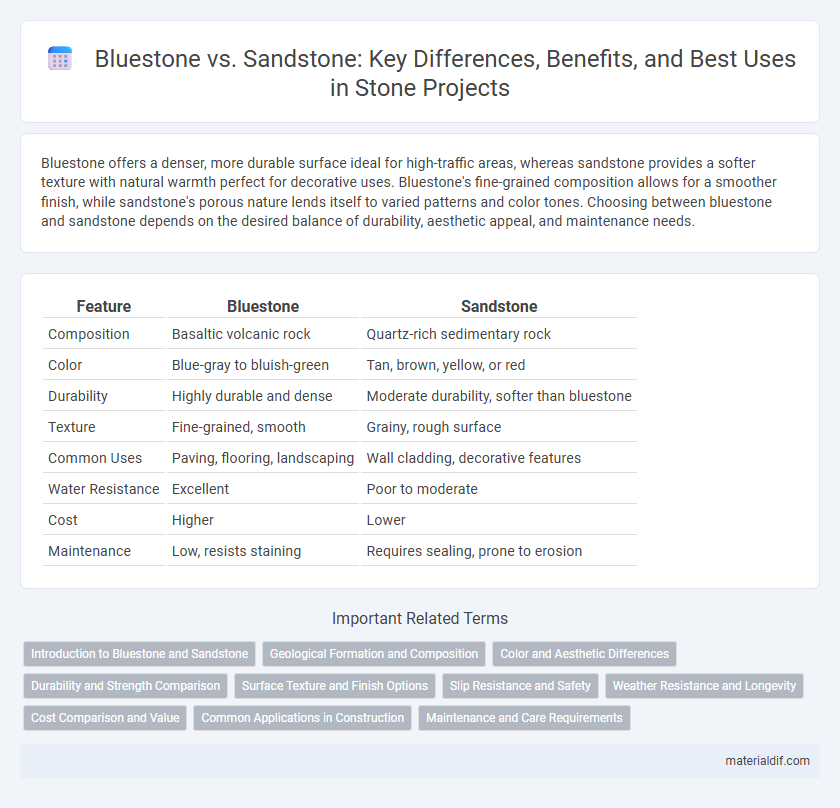Bluestone offers a denser, more durable surface ideal for high-traffic areas, whereas sandstone provides a softer texture with natural warmth perfect for decorative uses. Bluestone's fine-grained composition allows for a smoother finish, while sandstone's porous nature lends itself to varied patterns and color tones. Choosing between bluestone and sandstone depends on the desired balance of durability, aesthetic appeal, and maintenance needs.
Table of Comparison
| Feature | Bluestone | Sandstone |
|---|---|---|
| Composition | Basaltic volcanic rock | Quartz-rich sedimentary rock |
| Color | Blue-gray to bluish-green | Tan, brown, yellow, or red |
| Durability | Highly durable and dense | Moderate durability, softer than bluestone |
| Texture | Fine-grained, smooth | Grainy, rough surface |
| Common Uses | Paving, flooring, landscaping | Wall cladding, decorative features |
| Water Resistance | Excellent | Poor to moderate |
| Cost | Higher | Lower |
| Maintenance | Low, resists staining | Requires sealing, prone to erosion |
Introduction to Bluestone and Sandstone
Bluestone and sandstone are both sedimentary rocks widely used in construction and landscaping for their durability and aesthetic appeal. Bluestone is typically a dense, fine-grained sandstone or limestone that exhibits a distinctive blue-gray color and is prized for its strength and resistance to weathering. Sandstone varies more broadly in color and texture, composed mainly of sand-sized mineral particles, offering versatility in design but generally less density compared to bluestone.
Geological Formation and Composition
Bluestone forms predominantly from basalt or dolerite, resulting from rapid cooling of lava flows in volcanic settings, characterized by a dense, fine-grained texture rich in feldspar and pyroxene minerals. Sandstone originates from sedimentary processes where compacted sand grains, primarily quartz and feldspar, cement together over millions of years in riverbeds, deserts, or marine environments. The mineral composition and formation environment lead to Bluestone's greater durability and uniformity compared to the more porous and layered structure of Sandstone.
Color and Aesthetic Differences
Bluestone typically exhibits a bluish-gray or slate-blue color with subtle variations, creating a modern and sleek aesthetic ideal for patios, walkways, and architectural features. Sandstone features warmer tones ranging from beige, tan, and yellow to red, offering a rustic and natural appearance well-suited for landscaping, wall cladding, and garden paths. The color stability of bluestone surpasses sandstone, which may fade or change hue over time due to exposure to sunlight and weather conditions.
Durability and Strength Comparison
Bluestone exhibits higher durability and greater compressive strength compared to sandstone, making it more resistant to weathering and erosion in outdoor applications. Sandstone, while aesthetically versatile, tends to be softer and more porous, resulting in lower resistance to mechanical stress and potential for faster deterioration. Choosing bluestone ensures longevity and robustness for structural and paving projects where strength is critical.
Surface Texture and Finish Options
Bluestone features a fine-grained, dense surface texture with a smooth to slightly rough finish, often used in polished, honed, or flamed options to enhance its durability and visual appeal. Sandstone exhibits a coarser, grainy texture with natural cleft and tumbled finishes, providing a rustic and slip-resistant surface suitable for outdoor applications. Both stones offer versatile finish options tailored to aesthetic preferences and functional requirements, with bluestone favoring modern sleekness and sandstone embracing a more natural, rugged look.
Slip Resistance and Safety
Bluestone offers superior slip resistance compared to sandstone due to its naturally textured surface, making it a safer choice for outdoor walkways and pool decks. Sandstone, while aesthetically appealing, tends to become slippery when wet because of its smoother finish and softer composition. Prioritizing slip resistance, bluestone enhances safety by reducing the risk of falls in high-traffic or moisture-prone areas.
Weather Resistance and Longevity
Bluestone exhibits superior weather resistance compared to sandstone due to its dense, fine-grained structure, making it less porous and more resistant to moisture absorption and freeze-thaw cycles. Sandstone, while aesthetically versatile, tends to be more porous and susceptible to erosion and surface deterioration over time, especially in harsh climates. Consequently, bluestone generally offers greater longevity and durability for outdoor applications such as paving and cladding.
Cost Comparison and Value
Bluestone typically comes at a higher price point than sandstone due to its durability and aesthetic appeal, offering longer-term value in landscaping and construction projects. Sandstone is generally more affordable and widely available, making it a cost-effective option for budget-conscious applications. When evaluating cost versus value, bluestone's resistance to weathering and low maintenance needs often justify its initial investment compared to sandstone.
Common Applications in Construction
Bluestone is widely used for outdoor applications such as patios, walkways, and pool coping due to its durability and slip-resistant surface. Sandstone, valued for its aesthetic appeal and ease of carving, is commonly employed in decorative facades, interior flooring, and landscaping elements. Both stones offer unique textures and colors, making them popular choices in residential and commercial construction projects.
Maintenance and Care Requirements
Bluestone requires minimal maintenance due to its dense composition, resisting stains and weathering effectively, making it ideal for outdoor patios and walkways. Sandstone, being more porous, demands regular sealing and cleaning to prevent moisture absorption, discoloration, and erosion over time. Proper care for sandstone includes gentle cleaning with non-acidic solutions and periodic resealing to maintain its appearance and durability.
Bluestone vs Sandstone Infographic

 materialdif.com
materialdif.com